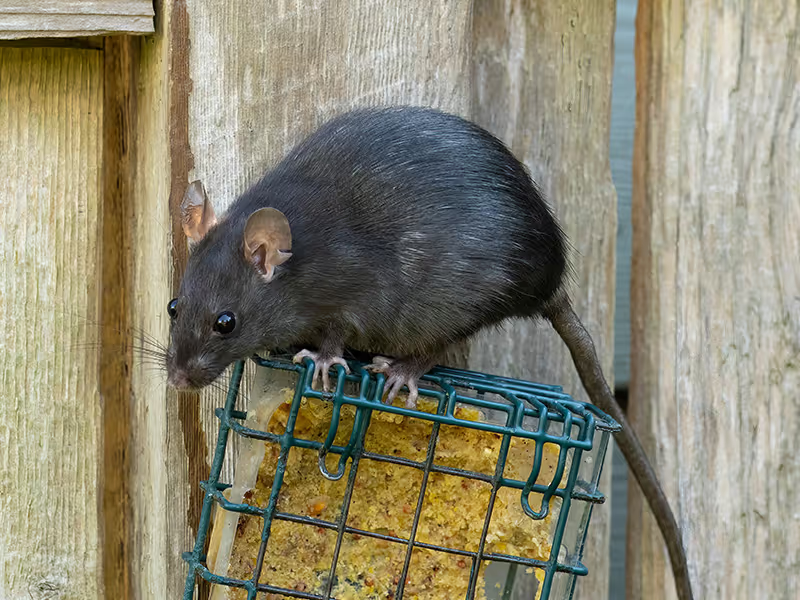Roof rats are brown or black rodents with white or black undersides. They have long, hairless tails that are longer than their bodies, smooth fur, pointed noses, and large ears and eyes.

Roof rats can reach up to 16” long and weigh between 5-9 ounces.
The differences between roof rats and Norway rats lie in size, color, and overall appearance. Roof rats are slender rodents with pointed noses, large ears, and tails longer than their bodies. In contrast, Norway rats are stocky, with blunt noses, smaller ears, and tails shorter than their bodies.
Roof rats are attracted to homes that provide easy access to food, water, and elevated shelter. These agile climbers are especially drawn to overgrown vegetation, tree branches touching the roof, and ivy-covered walls, which offer direct pathways into attics and upper levels of a home. Unsealed vents, gaps in roofing, and open soffits serve as convenient entry points. Once inside, roof rats seek out warm, undisturbed areas like attics, wall voids, and ceiling spaces to build their nests. Accessible food sources—such as pet food, unsecured trash, bird feeders, and crumbs in kitchens—further increase the likelihood of a roof rat infestation.
Roof rats typically get inside through small openings in the roofline, attic vents, eaves, gaps in soffits, and even through chimneys. Overhanging tree branches, utility lines, or vines growing on the side of a house can act like highways, giving them easy access to the roof. Once on the roof, they can squeeze through openings as small as a half-inch wide. If a home has damaged shingles, loose flashing, or poorly sealed vents, these rats can quickly find a way in.
Roof rats typically nest in the upper parts of structures, as they prefer elevated, secluded areas. In homes, they are most often found nesting in attics, ceilings, rafters, and the spaces between walls. They may also nest in insulation, storage boxes, or other cluttered areas where they can stay hidden and undisturbed.
What are the signs of a roof rat infestation?
If you suspect a roof rat infestation in your home, watch for the following signs:
Roof rats can pose serious health risks to both humans and pets. They are capable of transmitting diseases through scratches and bites and often carry fleas, which can spread illnesses from rats to people or animals. In addition, roof rats can contaminate food and water sources with their droppings and urine, increasing the risk of illness.
Can roof rats cause damage to wires, insulation, or structures?
Roof rats are known for chewing on materials such as wires, drywall, and wooden beams. Insulation also provides an ideal resource, helping them stay warm and create nests for their young.
Roof rats can be difficult to eliminate without professional help. These pests often nest in multiple areas of a home, and missing even a single hole or gap, or improperly using traps or treatments, can result in the false impression that the infestation has been resolved.
If rats have infested your home, skip the DIY traps and baits and contact Harbor Pest Control for assistance. Our local pest control team has been solving rat problems in San Diego since 1948; you can rely on us to develop a treatment plan that will eliminate these destructive pests.
Preventing roof rats is straightforward. We recommend:





Helpful Tips & Info